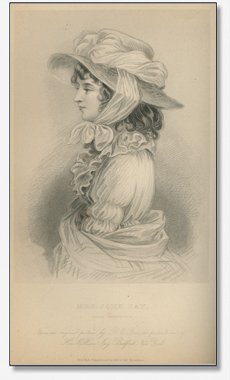
Rufus W. Griswold, The Republican Court, or, American Society in the Days of Washington. New and rev. ed. (New York, 1856), plate opposite 97. First ed., 1855.
SARAH LIVINGSTON JAY (1756-1802) Daughter of William Livingston, the popular governor of New Jersey, and M. Susannah French of New Brunswick, Sarah (“Sally”) Van Burgh Livingston came from a family of wealthy landowners. On April 28, 1774, Sally married John Jay (1745-1829), a New York politician who would become the first chief justice of the Supreme Court of the United States, and a two-term governor of New York State, as well as an influential diplomat abroad. While the union certainly provided Jay with social and political networking opportunities, surviving letters between the couple indicate that the Jays’ marriage was also affectionate, and produced five surviving children, Peter Augustus, Maria, Anne, William, and Sarah Louisa. In the early years of their marriage, Sally stayed at her father’s house in Elizabethtown, New Jersey, where Jay would visit when not serving as a state official in New York. In 1779, he was appointed commissioner to Spain. While living there, Sally corresponded with her sister Catherine Livingston, revealing her own political opinions and patriotism openly, and treating her role as a “lady of society” with a sense of humor. She writes:
One observer, Janet Montgomery, once said that Sally Jay’s thoughtful manners and knowledge would “do honor to our countrywomen…at the Court of Madrid.” This prediction held true, for while in Spain, she was a popular figure in court society. In 1782, the Jays moved to Paris, where Jay helped to negotiate a peace treaty with England, and Sally became acquainted with the different facets of pre-Revolutionary France. She visited the French Court, where she saw Marie Antoinette; there she also met Madame Lafayette, with whom she would soon become close friends. In addition, during these days in Paris, Sarah became a member of the intellectual circle that surrounded Benjamin Franklin. The family returned to America after the finalizing of the Treaty of Paris, and John Jay was appointed the Secretary of Foreign Affairs. Later, he became the first Chief Justice of the Supreme Court in the new American government. When the family settled in New York, Mrs. Jay became a leading figure in the elite social circles in the city. After attending one of the Jays’ parties, Mrs. Abigail Adams Smith commented on the evidence of “European taste.” In 1794, John Jay departed for England, where he negotiated the Treaty of Amity, Commerce and Navigation, known as “Jay’s Treaty,” which helped improve relations with Great Britain, but angered many who favored France. Upon return to America, Jay found that, in his absence, he had been elected the second governor of New York State. Five years later, in 1801, the Jays retired to a farm near Bedford, New York, where Sarah Livingston Jay died in 1802. Written by Emily Toner; edited by Annie Turner. ______________________ [1] Sarah Livingston to Catharine and Susan Livingston, March 4, 1780, as quoted in Selected Letters of John Jay and Sarah Livingston Jay (Jefferson, N.C.: McFarland & Co., 2004), p. 74. |

